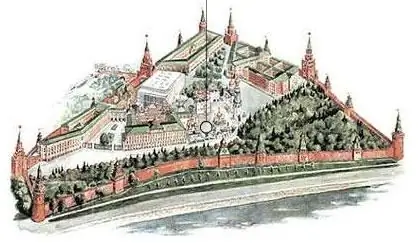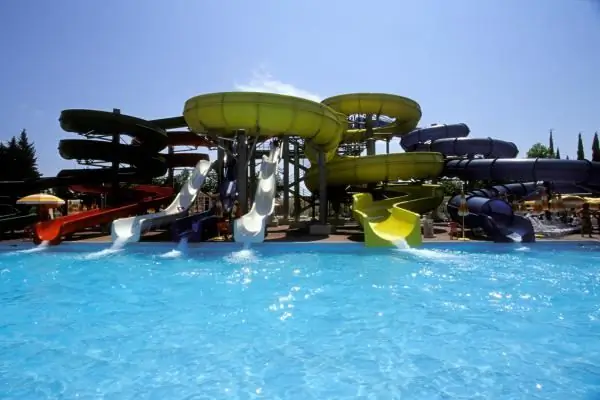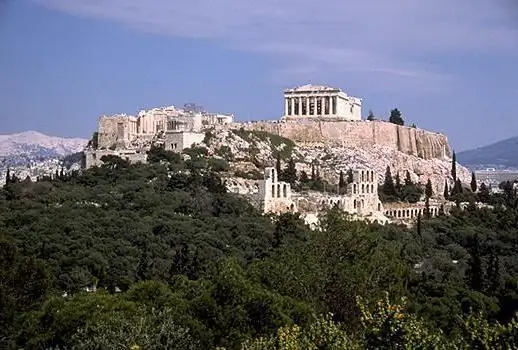- Author Harold Hamphrey [email protected].
- Public 2023-12-17 10:06.
- Last modified 2025-01-24 11:10.
The capital of Tatarstan - one of the oldest centers of civilization - is called by many "the city of unique monuments". Indeed, more than one generation of scientists and educators, poets and craftsmen, generals and just heroes have grown up on the land of Kazan, rich in sights and traditions. The history of the city is connected with the fate of Derzhavin, Pushkin, Chaliapin, L. Tolstoy, Lobachevsky and others.
General information
Kazan, in terms of its historical values and the preservation of cultural heritage, is practically not inferior to such megacities as St. Petersburg or Moscow. After all, it is not for nothing that it is considered the Russian third capital. Its architectural monuments are of great value for the history of Russia. And such masterpieces as Syuyumbike - the leaning tower, the oldest building from the time of Ivan the Terrible, the Annunciation Cathedral of the Kazan Kremlin that has survived to this day, the Cannon Yard complex (since Petrovsky time), amaze with their architectural forms. Moreover, the Governor's Palace with the Kul-Sharif Mosque received the status of a worldtreasures.

Under the auspices of UNESCO was taken the only Tatar fortress that exists today in the world, built many centuries ago and retaining its original features. This is the Kazan Kremlin, a photo of which is brought home by every tourist who has visited this city.
Pearl of Tatarstan
The very first buildings on the territory of the fortress appeared at the beginning of the eleventh century. It was then that the Bulgar tribes settled on the hill, on which the ancient building now flaunts, and began to build a wooden military outpost - the Kazan Kremlin.
Kazan developed, and the citadel with its mausoleums and mosques existed until the middle of the sixteenth century. But in 1552 the city was completely destroyed by Ivan the Terrible. In the same year, construction began on another, new Russian fortress on the banks of the Volga. It was built by Pskov craftsmen, led by Postnik Yakovlev and Ivan Shiryai.

Architecture
The Kazan Kremlin is framed by an ancient fortress wall. It is completely built of white Volga limestone. The towers of the Kazan Kremlin in the amount of eight pieces date back to the sixteenth century. At the same time, the Annunciation Orthodox Cathedral was built. A little later, in the eighteenth century, Syuyumbike, a leaning tower, was built. The complex of buildings at the Cannon Yard and the Junker School were erected in the nineteenth century, and the Kul-Sharif Mosque is in our time.
The hill on which the Kazan Kremlin is built is surrounded by water on three sides. It wasan ideal place to build a fort. The very first fortifications of the Bulgar nomadic tribes appeared on the bank of a small river at the turn of the tenth and eleventh centuries, although some archaeological finds are evidence that a settlement existed on this site much earlier.
History of the Kazan Kremlin
The stone fortress was erected to defend the northern borders of the Volga Bulgaria. By the middle of the thirteenth century, the Mongol troops, led by Batu Khan, had advanced significantly in the east deep into Europe. The dominance of the Golden Horde was established not only over Russia and the Crimea. At the same time, Bulgaria also fell, turning into a Mongol province.

After the destruction of the city of Bulgar, the new capital was moved to Kazan. The local Kremlin became the residence of the ruler, and the city itself was renamed. But the locals did not accept the new name, so the principality was called the Kazan ulus.
After the death of the Golden Horde in 1438, an independent khanate was founded. Active work began to strengthen the stone walls of the Kremlin. They, according to the chroniclers, became "impregnable in battle."
A palace and mosques were erected on the territory - the stone Nur-Ali and the wooden Khan's, which was later named after the seid Kul-Sharif. It was he who defended the Kazan Kremlin from the soldiers of Ivan the Terrible in 1552.
Russian fortress
To this day not a single Khan's building has survived. Moreover, when in the middle of the sixteenth century the Kazan Kremlin turned into a Russianfortress, on the sites of Muslim buildings - "the focus of infidelity" - began to build Orthodox churches. Even Syuyumbike, mistakenly attributed to the buildings of the Khan's period until the nineteenth century, was built much later, already in Russian times. And the proof of this are many elements, their architecture, especially pilasters and places for images.
After the conquest of the city, Ivan the Terrible sent architects there. They started a new building. At first, the main structures - temples and towers - were built of wood. It is believed that the first stone church was built in honor of St. Nicholas the Wonderworker.
Imperial residence
In the first half of the nineteenth century, Nicholas I decides that the governor of the city will carry out the functions of the royal governor. At the same time, it was conceived that the Kazan Kremlin, the photo of which testifies to the monumentality of this architectural complex, would become the imperial residence. In this regard, the construction of the governor's palace began. The building was designed by the architect Konstantin Ton. It was he who came up with the idea of creating a smaller analogue of the Grand Kremlin Palace in Kazan. Nicholas I personally followed the progress of construction work. As a result, the building turned out to be a vivid example of a mixed Russian-Byzantine style, decorating the Kazan Kremlin.
Tour

During its thousand-year history, the complex of architectural monuments has repeatedly changed its appearance. But masonry preserved deep undergroundthe foundations of ancient mosques and towers, as well as many burials, still remain. Now the museums of the Kazan Kremlin are open for visitors on the territory, dedicated not only to this ancient fortress, but also to the history of the people, Islamic culture and nature of this region in general. There is also a memorial of the Great Patriotic War in memory of three hundred and fifty thousand Tatarstan residents who did not return from the front.
Spasskaya Tower

The first thing tourists see when approaching the Kazan Kremlin is the Spasskaya Tower. It is made in the Bulgarian style and crowned with a double-headed eagle. The tower was built in the 1660s. It has been repeatedly updated and rebuilt.
In addition to the Spasskaya Tower, seven more similar structures have been preserved on the territory of the fortress - Voskresenskaya, Preobrazhenskaya, South-Eastern and South-Western, Konsistorskaya, Bezymyanny and Taynitskaya.
Syuyumbike
The building attracts the main attention in the ensemble. Higher than the famous Leaning Tower by two meters, this tower began to lean immediately after construction was completed. By 1930, its angle of inclination had reached a critical point of one hundred and twenty-eight centimeters. And if it were not for the restoration and strengthening work, its roll would have been much greater.
The Syuyumbike Tower is called the recognized architectural symbol of the capital of Tatarstan. It is already impossible to imagine Kazan without it, just like Egypt without the pyramids, and Paris without the Eiffel Tower.

The graceful silhouette of this building attracts the attention of tourists, and the stories about itlegends and myths are truly fascinating. Here is one of them. Ivan the Terrible, who conquered Kazan, liked the beautiful queen. However, the beautiful Syuyumbike, who received a marriage proposal from the Russian sovereign, set a condition: to build in seven days such a tower, higher than which there would be no higher in the city. Within the specified time, her wish was fulfilled. And Syuyumbike herself, who allegedly decided to say goodbye to her beloved people, climbed this building and threw herself from it. Since then, the tower has begun to tilt downwards…
Governor's Palace
This pompous building is not only a cultural value. Today it, as in ancient times, performs political and administrative functions. Once an imperial palace, today the palace is the residence of the President of Tatarstan. Many adjacent buildings house ministries and various departments.
Annunciation Cathedral
It is truly one of the oldest monuments of Russian architecture preserved in the capital of this republic. The Annunciation Cathedral of the Kazan Kremlin was founded on October 4, 1552 by order of Ivan the Terrible. The wooden church was cut down in just three days in a wasteland. And already on the sixth day of the same month it was consecrated in honor of the Annunciation of the Most Holy Theotokos. The main part of the activity of many saints of Kazan is connected with this unique cathedral, and here they are buried. The cell of the first bishop of this diocese, Archbishop Guria, has also been well preserved. And on the eastern part of the wall, by some miracle, an ancient fresco depicting the image of the Savior Not Made by Hands has been preserved.
Kul MosqueSharif
The list of monuments of the Kazan Kremlin includes a modern, but very beautiful building. This is the Kul Sharif Mosque. For the first time, a solemn prayer sounded in it on the twenty-fourth of June 2005. It bears the name of Said Kul-Sharif. It was the imam of that mosque called Al-Kabir, which existed here in the era of the Kazan Khanate and was destroyed by the soldiers of Ivan the Terrible.
Today, Kul-Sharif is considered a tribute to the memory and respect of distant ancestors. The mosque is a highly original synthesis of architectural styles and traditions most prevalent in the Islamic world.

Kul-Sharif was built and today is positioned as the main mosque for all Tatars living on the planet. This is a festive Friday Muslim church, so prayers are read in it no more than once a day. Mostly, crowds of tourists come to the mosque, for whom there are neither weekdays nor holidays.
How to get there
Kazan Kremlin is located on the left bank of Mother Volga. You can get to it by buses 6, 29, 37, 35, 47 and other routes, by trolleybus, as well as by metro. The Kremlin station was built next to it. Those who arrive by public transport can get off at the bus stop "TsUM", "st. Bauman", "Palace of Sports" or "Central Stadium".
Entrance to the territory of the Kazan Kremlin is free. You can go through the gate from the side of the Spasskaya Tower.

Reviews
After the revolution, the complex of architectural structures was badly damaged. But when inIn the nineties of the last century, the Kazan Kremlin received the status of the residence of the President of Tatarstan, restoration work began to be carried out here. Today, tourists call this ancient fortress the first sight of the city, every centimeter of which is permeated with history.

At the end of the last century, work began on the reconstruction of the Kul-Sharif mosque. And today it is considered one of the largest in all of Europe. And in 2003, a symbolic sculpture was installed in the park next to the Cathedral of the Annunciation. It was called "Architects of the Kazan Kremlin". From the sculpture, architects - Russian and Tatar - look at their work. After all, the fruit of their work - a unique architectural ensemble - was created and revived by the efforts of these two peoples.
Tourists complain: one or two days are not enough to see all the sights of the Kazan Kremlin. Some, those who are limited in time, choose a sightseeing tour. It lasts one and a half to two hours and costs about six hundred rubles for a group of up to ten people. Most of all visitors are impressed by the Annunciation Cathedral of the Kazan Kremlin. This snow-white building with blue-blue domes, according to many believers, literally turns their worldview upside down.

The beginning of this millennium Kazan Kremlin met included in the heritage of UNESCO. This unique value of the complex - a witness to the falls and rises of entire peoples that inhabited the Volga region at different times - is necessarily noted in their reviewsthose who have been here.






